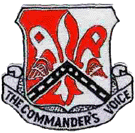

(above picture)82nd Signal Co
Pocket Patch
 Click above to order
Click above to order
The History of the
82nd Signal Battalion
WW I and WW II
|
The 82nd Signal Company
Unit History
 he 307th Field Signal Battalion was
constituted in the National Army in 1917 at Camp Gordon, Georgia. The battalion had an enlisted
strength of 471 men. The signal unit was divided into outpost, wire and radio companies, supply and
headquarters detachments he 307th Field Signal Battalion was
constituted in the National Army in 1917 at Camp Gordon, Georgia. The battalion had an enlisted
strength of 471 men. The signal unit was divided into outpost, wire and radio companies, supply and
headquarters detachments
Following an intense training period, the battalion set sail on 18 May 1918 on the
British ship "Virginian" for Liverpool, England with a final destination of Laltaviw, France.
For the first time in their short history, the battalion was moving into harm's way to provide
tactical communications.
Once in France, the battalion moved to Toul. Their orders were to relieve the
101st Field Signal Battalion. It was here that the signaleers received their baptism of
fire. German artillery constantly harassed the battalion with gas and high explosive shelling.
On 10 August, 1918 the 307th was ordered to the northern sector of Nancy, France, where
it relieved the 1st Field Signal Battalion of the 2d Infantry Division.
German air raids were frequent while the battalion was in sector. During one attack,
all vehicles from the division forward were put out of commission by the concussion of a large
aerial bomb that exploded 200 feet from the battalion's telephone wires that were strung on standard
telephone poles. The division came out of the front lines and withdrew into the area north on Nancy.
On 22 September, the division, along with the signal battalion, was given orders to proceed to
the Argonne Forest. The battalion was held in reserve for a few days in preparation of the second
great attack of the American Army that was possibly one of the deciding factors of the outcome of
World War I.
The signaleers of the 307th often worked 39 to 40 hours without rest,
laying communications lines and maintaining them under shellfire of high explosives and gas.
The signalmen of the Outpost Company went along with the Infantry setting up instant communications
every time an objective was reached. Uncommon valor was very common.
On 31 October 1918, the division was relieved from the front 11 days before the
armistice was signed. Prior to departure, General John J. Pershing reviewed the 307th Field Signal
Battalion. The unit departed for America on 06 May 1919 and was demobilized at Camp Harrison, Virginia,
on 22 May 1919. On 24 June 1921, the 307th Field Signal Battalion was reconstituted as the
82d Signal Company and alotted to the Organized Reserves of the 82d Infantry Division.
Less than four months following the attack on Pearl Harbor and the United States'
entrance into World War II, the 82d Signal Company was ordered to active duty. On 15 August 1942, the
unit was reorganized and re-designated as the 82d Airborne Signal Company and the Airborne tab was added
to the "All American" patch.
The Signal Company's first taste of combat during World War II came on the night of
9 July 1943, when a signal detail supporting the 505th Parachute Combat Team (commanded by
Colonel James Gavin) parachuted behind enemy lines at Gela to spearhead the invasion of Sicily.
The campaign was marked by a tiring game of leap frog. The company established and maintained eight
separate command posts. Upon completion of the Sicilian campaign, preparations were made for future
operations on the Italian mainland. The Company supported the 504th and 505th
Parachute Combat Teams already in Salerno. Following the capture of Naples, the Signal Company moved to
Ireland for rest and recuperation.
On 6 June 1944, paratroopers of the Signal Company filled three C-47s and seven
gliders in preparation for the D-Day assault In 33 days of extreme combat following the initial assault,
the Company suffered the following casualties: nine enlisted paratroopers killed in action, one officer
and seven enlisted paratroopers missing in action and 26 paratroopers injured. No replacements were
provided for these paratroopers. The high amount of casualties coupled with no replacements and a high
loss of equipment due to glider crashes seriously impeded the operational effectiveness of the Company
for combat operations. In spite of these circumstances, the Company maintained communications. Once
again, uncommon valor was the norm. Paratroopers from the company received one Silver Star, six Bronze
Stars and 16 Purple Hearts. The Company was awarded the Presidential Unit Citation, the French De Guerre with Palm and
the French Fourragere.
The Company was sent back to England to prepare for the upcoming invasion of Holland,
Operation Market Garden. The unit was brought to full strength and reequipped. On 17 September 1944,
the Signal Company made its third combat jump into Holland.
The "All American Signalmen" returned to France to rest and refit. At
Sissone, France, they quickly modified the wire network and Division Command Post network to meet the
changed requirements of divisional headquarters and subordinate units but were quickly
on the move again. On 17 December 1944, the Company was alerted to begin movement to Werbomont,
Belgium. Once in Werbomont, wire and radio communications were established to all Division units.
The Company then began a series of movements with the Division as they drove deep
into the heart of Nazi Germany. At Ludwigslust, Germany, the Company maintained and repaired over two
hundred miles of commercial wire, installing and operating the telephone system at the Division
headquarters. In Berlin, Germany, the Company installed a telephone central office and provided local
phone service to the Division Command Post. A Division message center, referred to as Champion Radio,
was set up to provide secure and rapid message transmission.
The Company remained in Berlin until their return to the United States aboard the
Queen Mary on 3 January 1946. On 12 January, more than one million enthusiastic spectators gave the 82d
Airborne Division troopers a gala reception as they headed a tremendous victory parade up
New York City's Fifth Avenue.
On 19 January 1946, following a much needed furlough, the Company reassembled at
Fort Bragg, North Carolina. In March of 1948, the Company was demobilized and allotted to the Organized
Reserve Corps. Nine months later they were reactivated and allotted to the Regular Army and the 82d
Airborne Division.
On 1 September 1957, the 82d Signal Company was reorganized into the 82d Signal
Battalion (Airborne).
books
R E L A T E D B O O K S
Astor, Gerald
A Blood-Dimmed Tide: The Battle of the Bulge by the Men Who Fought It.
Mass Market Paperback, 1994 ISBN: 0440215749
Badsey , Stephen & Chandler, David G (Editor)
Arnhem 1944:
Operation "Market Garden" (Campaign No.24) 1993
96p. ISBN: 1855323028
Black, Wallace B.& Blashfield, Jean F. Battle of the Bulge
(World War II 50th Anniversary Series). Crestwood House, 48 pp May,1993 ISBN: 0896865681
Breuer, William B Geronimo! American
Paratroopers in WWII. New York: St. Martin Press, 1989 621 p. ISBN: 0-312-03350-8
Breuer, William B Drop Zone Sicily:
Allied Airborne Strike,July 1943. Novato, CA: Presidio, c1983. 212 p. ISBN: 089 141 1968
Breuer, William B
They Jumped at Midnight Jove Publishing, (P) c1990 ISBN: 0515104256
Burriss, T Moffatt
Strike and Hold: A Memoir of the 82nd Airborne in WW II Brasseys, Inc, 256 pp August,2000 ISBN: 1574882589
D'Este, Carlonbsp;
Decision in Normandy William S Konnecky Assc(P), 560 p. ISBN: 1568522606
D'Este, Carlo
Patton: A Genius for War 1024 pp ISBN: 0060927623
Falerios, Kenton J.
Give Me Something I Can't Do: The History of the 82nd Military Police Company, WW 1 to Iraq
Nov 2007, Authorhouse, 192 p ISBN: 1434337197
Gavin, James M.
On to Berlin : Battles of an Airborne Commander, 1943-1946 ISBN: 0670525170
Hastings, Max Overlord: D-Day and the Battle for Normandy Simon and Shuster(JUV), 396 p.
ISBN: 0671554352
Keegan, John The Second World War Penguin
(P), 708 p. ISBN: 014011341X
Keegan, John Six Armies in Normandy: From D-Day to the Liberation of Paris Penguin USA(P), 365 p.
ISBN: 0140235426
MacDonald, Charles B A Time For
Trumpets: The Untold Story of the Battle of the Bulge Wm Morrow & Co
(P), 720 p. ISBN: 068151574
Messina , Phillip Anzio: Song of
Destiny A.G.Halldin Publishing Company, 1992. ISBN: 0 935 64838 0
Mullins, Christopher Eric (Moon) The Commander's Voice- The History of the 82nd Signal Battalion during WWI and WWII
Amazon Apr 7, 2021. 186 p. ISBN-13 : 979-8734584361
Nigl, Dr Alfred J & Charles A Nigl
Silent Wings - Savage Death Santa Ana, CA: Graphic Publishing, Dec 3,2007. 288 p. ISBN: 1882824318
O'Donnell, Patrick K. Beyond Valor
Free Press, 2001, 384 p. ISBN: 0684873842
Ryan, Cornelius
The Longest Day Touchstone Books (P), 350 p. ISBN: 0671890913
Ryan, Cornelius
A Bridge Too Far 670p. ISBN: 0684803305
The Center of Military History
The War in the Mediterranean: A WWII Pictorial History Brasseys, Inc.,
465 p. ISBN:1574881302
Verier, Mike
82nd Airborne Division in
Colour Photographs (Europa Militaria, No 9) ISBN: 187 200 4857
Wildman, John B All Americans 82nd
Airborne. Meadowlands Militaria, 6/83 ISBN:091 208 1007
|